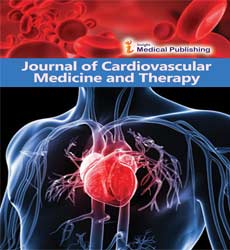Modern Benefits in Management of Chronic Heart Failure
Quevedo Ferenc*
Department of Hypertension, Marmara University, Istanbul, Turkey
- Corresponding Author:
- Ferenc Q
Department of Hypertension, Marmara University, Istanbul, Turkey
E-mail: ferencqu@hotmail.com
Received date: February 01, 2021; Accepted date: February 15, 2021; Published date: February 22, 2021
Citation: Ferenc Q (2021) Modern Benefits in Management of Chronic Heart Failure. J Cardiovasc Med Ther Vol.4 No.1: 04
Abstract
Keywords
Chronic heart failure; Left ventricle; Arrhythmia
Description
Chronic heart failure (CHF) stays the only cardiovascular sickness with an expanding hospitalization trouble and a progressing channel on medical care uses. The pervasiveness of CHF increments with propelling life expectancy, with diastolic cardiovascular breakdown prevailing in the older populace. Essential avoidance of coronary conduit sickness and danger factor the board by means of forceful circulatory strain control are focal in forestalling new events of left ventricular brokenness. Ideal treatment for CHF includes ID and remedy of conceivably reversible precipitants, target-portion titration of clinical treatment, and the board of hospitalizations for decompensation. The etiological aggregate, outright lessening in left ventricular launch portion and an extending of QRS term on electrocardiography is regularly used to distinguish patients at expanded danger of movement of cardiovascular breakdown and unexpected demise who may profit by prophylactic implantable cardioverter-defibrillator arrangement with or without heart resynchronization treatment. Patients who change to cutting edge phases of infection notwithstanding ideal conventional clinical and gadget treatment might be contender for hemodynamically coordinated methodologies, for example, a left ventricular help gadget; in chose cases, posting for cardiovascular transfer might be justified.
Discussion
Chronic heart failure (CHF) is a reformist condition that outcomes in a low quality of life for the patient and spots a financial weight on the medical care framework. In spite of advances in the control of cardiovascular infections, for example, myocardial dead tissue (MI), the occurrence and pervasiveness of CHF keep on expanding. A precise gauge of infection trouble is hard to accumulate in view of the immense number of patients with asymptomatic left Ventricular (LV) brokenness. As the populace ages, there is an epidemiological move toward a more prominent predominance of clinical cardiovascular breakdown with saved LV capacity, the purported hardened heart disorder. Indeed, cardiovascular breakdown with saved systolic capacity may represent up to 66% of cases in patients more established than 70 years. Despite age, the lifetime danger of creating cardiovascular breakdown is roughly 20% for all patients more seasoned than 40 years. Notwithstanding the developing pervasiveness, novel screening methods and helpful bearings have improved the standpoint for patients with cardiovascular breakdown by zeroing in on indication control as well as on enhancing the pathophysiology toward a remedial aggregate. This audit talks about acknowledged and arising remedial headings, with an accentuation on commonsense ramifications. Considering the accessible writing and clinical preliminaries, the essential accentuation will be on systolic brokenness, with a different brief conversation of cardiovascular breakdown with protected systolic capacity. No single test can be utilized to build up the clinical determination of cardiovascular breakdown. All things being equal, history and actual assessment discoveries giving indications and side effects of blockage or potentially end-organ hypo-perfusion are utilized to make the finding. Imaging considers archiving systolic or diastolic brokenness and biomarkers are useful extras. Actual assessment isn't useful in segregating among systolic and diastolic cardiovascular breakdown on the grounds that comparable discoveries, including cardiomegaly and a S3 dash, can be seen in both conditions.4 Pulmonary rales, frequently thought to be an indication of pneumonic venous clog, are regularly missing in CHF in spite of raised left-sided filling pressures. This nonattendance is because of persistent lymphatic hypertrophy, which forestalls alveolar edema in spite of raised interstitial pressing factors. Framingham rules, generally utilized in clinical exploration, involve a progression of major and minor standards that guide in the conclusion of cardiovascular breakdown and accentuate the significance of jugular venous pressing factor height, a S3 run, and a positive hepatojugular reflex in building up an analysis, while limiting the significance of lower furthest point edema. The utilization of mind type natriuretic peptides, in their dynamic or idle circling structures, has advanced during the previous decade; however the most grounded use stays in segregating between reasons for dyspnea when the finding is in uncertainty. Comorbid conditions should be considered on the grounds that renal inadequacy expands these levels and stoutness brings down them.
Conclusion
As the population ages and cardiovascular danger factors become progressively predominant, medical services experts in numerous orders will experience patients in danger of cardiovascular breakdown. Effective administration of this populace relies upon hazard factor decrease by means of way of life change and use of right now settled rules. During the past age, a blend of conduct, pharmacological, gadget based, and careful treatment modalities has enormously upgraded the endurance and personal satisfaction of patients with cardiovascular breakdown. Considering the expanding predominance of cardiovascular breakdown, proceeded with use of these standards and examination into novel treatment systems stay indispensable.
Open Access Journals
- Aquaculture & Veterinary Science
- Chemistry & Chemical Sciences
- Clinical Sciences
- Engineering
- General Science
- Genetics & Molecular Biology
- Health Care & Nursing
- Immunology & Microbiology
- Materials Science
- Mathematics & Physics
- Medical Sciences
- Neurology & Psychiatry
- Oncology & Cancer Science
- Pharmaceutical Sciences
